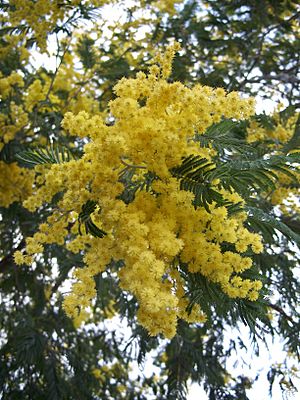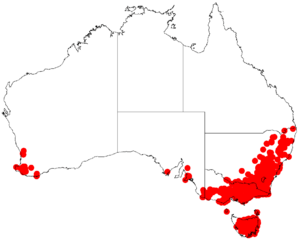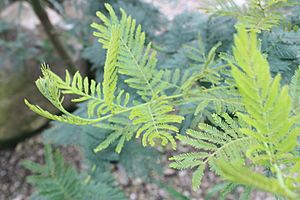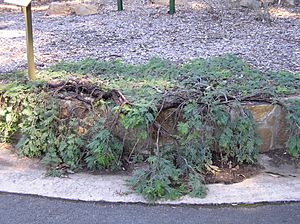Silver wattle facts for kids
Acacia dealbata, also known as the silver wattle, blue wattle, or mimosa, is a beautiful flowering plant that belongs to the family called Fabaceae. This family is also known as the legume family, which includes plants like peas and beans!
This plant originally comes from southeastern Australia, in places like New South Wales, Victoria, Tasmania, and the Australian Capital Territory. But it's so popular that people have planted it all over the world, especially in areas with warm weather, like the Mediterranean region.
Quick facts for kids Silver wattle |
|
|---|---|
 |
|
| Foliage and flowers | |
| Scientific classification | |
| Genus: |
Acacia
|
| Species: |
dealbata
|
 |
|
| Occurrence data from AVH | |
| Synonyms | |
|
|
Contents
What Does the Silver Wattle Look Like?
The silver wattle is a fast-growing plant that can be either a tree or a shrub. It can grow very tall, sometimes up to 30 meters (about 98 feet)! It's often one of the first plants to grow back after a bushfire.
Its leaves are quite special. They are a pretty blue-green or silvery-grey color. Each leaf is divided into many smaller parts, making them look feathery. These leaves can be up to 17 cm long.
Flowers and Fruit
The flowers of the silver wattle are bright yellow and grow in large clusters. Each cluster is made up of many tiny, round flowerheads. These flowerheads are packed with 13 to 42 individual flowers!
After the flowers, the plant produces flat pods. These pods are 2 to 11.5 cm long and contain several seeds.
How Long Do They Live?
Silver wattle trees usually live for about 30 to 40 years. In the wild, if there are no bushfires, other plant species will eventually take their place. In damp mountain areas, a white lichen can grow on the bark, which might be why it's called "silver" wattle. The Latin name dealbata also means "covered in a white powder."
Where Does the Silver Wattle Come From?
The silver wattle is part of a larger group of plants called Acacia. Scientists classify it with other wattles that have feathery leaves.
Some experts think that the silver wattle is actually a type of another plant called Acacia decurrens.
Different Types of Silver Wattle
There are two main types, or subspecies, of silver wattle:
- A. dealbata subsp. dealbata: This type grows in lower to middle elevations. It can be a tree up to 30 meters tall, and its leaves are usually 5–12 cm long.
- A. dealbata subsp. subalpina: This type grows in high mountain areas, like the Snowy Mountains. It's usually a shrub up to 5 meters tall, and its leaves are shorter, mostly 1.5–8.5 cm long.
Growing Silver Wattle in Gardens
People around the world love to grow silver wattle as an ornamental plant because of its beautiful flowers and silvery leaves. It has become common in many places, including parts of Russia, California, South Africa, and the Mediterranean region.
It can handle cold weather down to about -5°C (23°F), but it doesn't like long periods of frost. It grows best in a sunny spot with soil that is a bit acidic or neutral. The Royal Horticultural Society has even given it an award for being a great garden plant!
Mimosa Flowers
The flowers and young shoots of the silver wattle are often picked and sold as cut flowers. In flower shops, they are usually called "mimosa." In some countries like Italy and Russia, these flowers are often given to women on International Women's Day. The lovely scent from the flowers is also used to make perfumes!
Other Uses of Silver Wattle
The Ngunnawal people, who are the traditional owners of the land in the Australian Capital Territory, used the silver wattle in many ways. They made strong ropes from the bark and used the sticky sap as a glue. They also mixed the sap with ash to make special pastes for healing. The wood was used for tools, and the seeds were ground into flour.
The wood of the silver wattle is good for making furniture and other indoor items. It has a nice honey color and sometimes has cool patterns like "birdseye" or "tiger stripes." It's similar to its close relative, the blackwood tree, but it's lighter in color.
Sometimes, the leaves of the silver wattle are even used in Indian chutney!
Is Silver Wattle an Invasive Plant?
While silver wattle is beautiful, it can sometimes grow too well in new places. When a plant grows so much that it harms the native plants and ecosystems, it's called an invasive species.
In South Africa, it's considered a serious weed in some areas. In New Zealand, the Department of Conservation also calls it an environmental weed. In Spain, it's even against the law to introduce, own, or sell this plant in most areas because it can be a big threat to local species.
Images for kids
See also
 In Spanish: Acacia dealbata para niños
In Spanish: Acacia dealbata para niños




